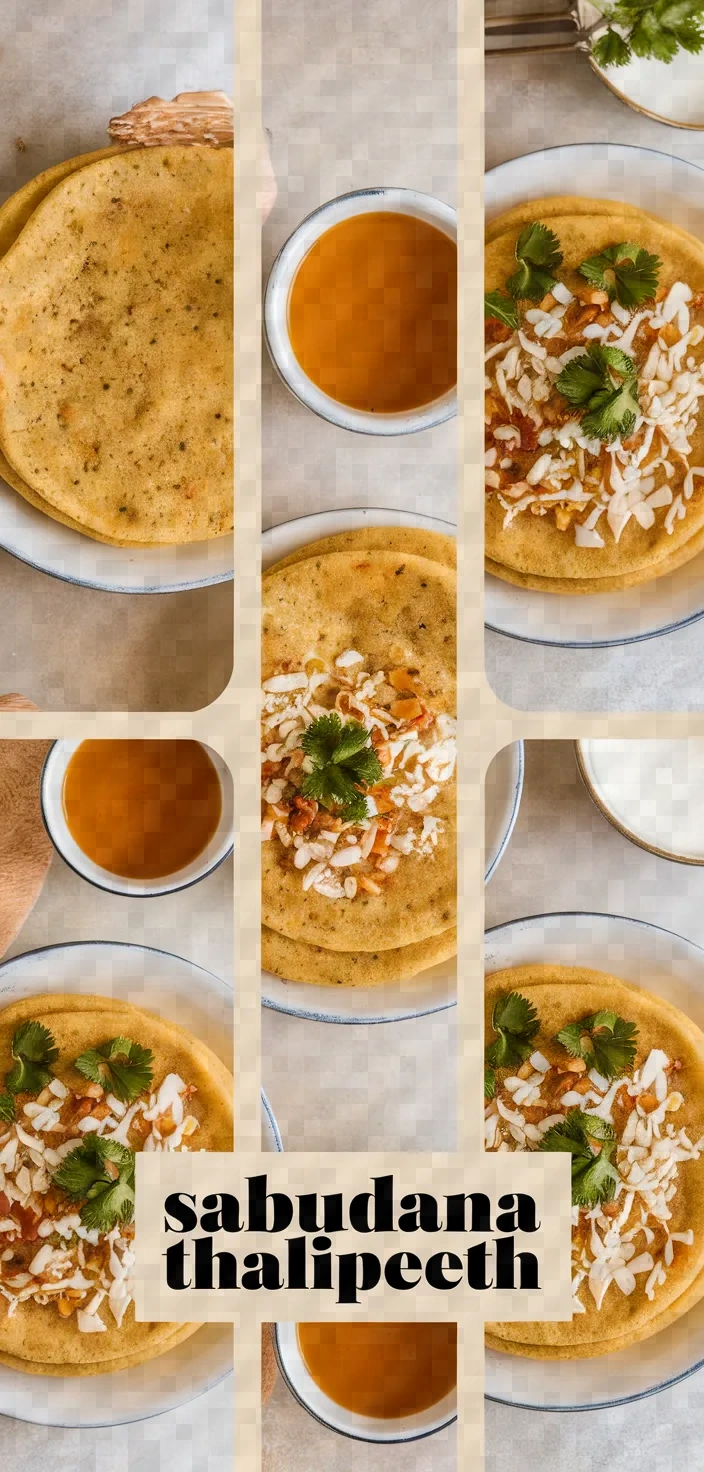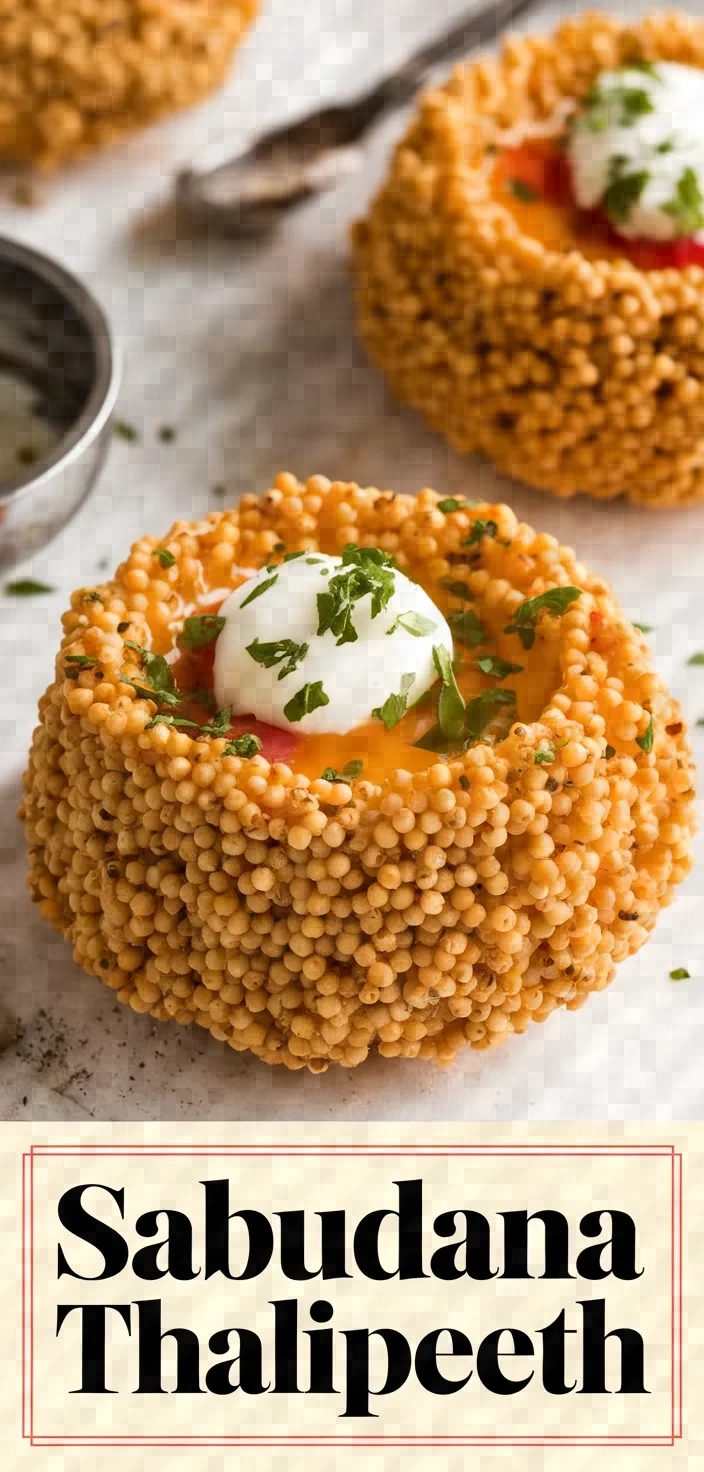When I’m craving a comforting breakfast that tickles my taste buds with a delightful mix of textures and flavors, this sabudana thalipeeth is my ultimate go-to! Imagine tapping into the earthy crunch of peanuts, the heat from green chilies, and the aromatic kick of cumin seeds—all coming together in crispy, golden bliss.

One of my favorite nutritious, filling go-to recipes is Sabudana Thalipeeth. I love the combination of boiled potatoes and coarsely ground roasted peanuts, which supply a wonderful energy boost.
Cumin seeds and fresh green chilies pack a flavorful punch and make this dish so incredibly tasty—it smells so good while it’s cooking!
Sabudana Thalipeeth Recipe Ingredients

- Sabudana (Tapioca Pearls): Rich in carbohydrates, providing quick energy.
- Potatoes: Adds creaminess and acts as a binding agent.
- Roasted Peanuts: Offers protein and a crunchy texture.
- Green Chilies: Adds a spicy kick and boosts flavor.
- Cumin Seeds: Enhances aroma and digestion benefits.
- Ghee or Oil: Provides richness and helps in cooking.
- Fresh Coriander Leaves: Garnish that adds freshness and color.
Sabudana Thalipeeth Recipe Ingredient Quantities
- 1 cup sabudana (tapioca pearls)
- 2 medium potatoes, boiled and mashed
- 1/2 cup roasted peanuts, coarsely ground
- 2 tablespoons ghee or oil
- 2 green chilies, finely chopped
- 1 teaspoon cumin seeds
- Salt, to taste
- 1 tablespoon fresh coriander leaves, chopped
- 1 teaspoon lemon juice (optional)
How to Make this Sabudana Thalipeeth Recipe
1. Wash the sago well under cold running water in order to clear away the excess starch until the water appears clear. Thereafter, allow the sago to soak in sufficient water for about 4-5 hours. If you are preparing the dish overnight, allow it to soak for a longer period. After soaking, drain the excess water from the sago, allowing it to expel any extra moisture.
2. In a mixing bowl, combine the soaked sabudana,
boiled and mashed potatoes,
coarsely ground roasted peanuts,
finely chopped green chilies,
cumin seeds,
and salt to taste.
3. Combine the constituents with gusto until a dough-like consistency is obtained. For those feeling particularly adventurous, feel free to add equal parts lemon juice and chopped fresh coriander leaves; the additional taste can really brighten up your mix.
4. Split the mixture into balls that are approximately the size of golf balls and are of equal size.
5. Fat a piece of plastic wrap, parchment paper, or a banana leaf with a little ghee or oil.
6. Place one ball on the greased surface and gently press it down with your fingers until it forms a round, thin disc about 1/4 inch thick.
7. Warm a non-stick frying pan or tawa over medium heat and pour some ghee or oil onto its surface.
8. With care, move the thalipeeth, now flattened, onto the pan. Allow it to cook on one side for approximately 4-5 minutes, or until you can see and smell that it is becoming golden brown and crispy.
9. Cook the other side of the thalipeeth, flipping it when necessary, and adding ghee or oil as needed, until both sides are cooked evenly and have a nice crispy texture.
10. Take it out of the pan and serve it hot; you could add a little yogurt or green chutney on the side, if you like.
Sabudana Thalipeeth Recipe Equipment Needed
1. Sieve or colander
2. Mixing bowl
3. Spoon or spatula
4. Knife
5. Cutting board
6. Measuring cups and spoons
7. Non-stick frying pan or tawa
8. Heat-resistant spatula or flat turner
9. Plastic wrap, parchment paper, or banana leaf
10. Grater or potato masher
11. Small bowl for oil or ghee
12. Skillet lid (optional, for covering)
FAQ
- Q: Can I use pre-soaked sabudana for this recipe?A: Indeed, let the sabudana soak in water for 4-5 hours or overnight, until its texture is soft enough to yield easily to your fingers and mash into the paste required for the next step.
- Q: Is it necessary to use ghee, or can I substitute it with oil?A: Any cooking oil of your choice can be used in place of ghee, but thalipeeth has a much richer flavor when made with ghee.
- Q: How can I make this dish spicier?A: To make it spicier, add more green chilies or include some red chili powder according to your taste.
- Q: What can I use instead of potatoes if I’m out of them?A: Boiled and mashed sweet potatoes can be used as a substitute, offering an only slightly different flavor.
- Q: How do I ensure the thalipeeth doesn’t stick to the pan?A. Ensure that the pan is proper heated and well-greased with ghee or oil before placing the thalipeeth on it.
- Q: Can I add vegetables to this recipe?Yes, you can add extra nutrition and flavor by including grated carrots or finely chopped spinach.
Sabudana Thalipeeth Recipe Substitutions and Variations
Substitute quinoa for texture when using this recipe to make sabudana vada.
2 medium potatoes, boiled and mashed, could be replaced with boiled sweet potatoes for a sweet twist.
1/2 cup roasted peanuts, coarsely ground, could be swapped out for almond flour to give a nutty flavor.
2 tablespoons of ghee or oil can be replaced with coconut oil for a distinct taste.
For a milder taste, 2 green chilies, finely chopped, can be replaced with red chili powder or paprika.
Pro Tips
1. Soaking Sabudana Ensure that the sabudana is soaked just right. Over-soaking can make them mushy, and under-soaking can leave them hard. They should be soft to the touch but not mushy after soaking.
2. Even Cooking When forming the discs, make a small hole in the center of each thalipeeth. This helps ensure even cooking throughout and prevents the middle from being undercooked.
3. Crunch Factor For an extra crispy texture, you can cook the thalipeeths on a low flame for a longer period, allowing them to become golden brown without burning. This slow cooking helps in achieving a delightful crunch.
4. Peanut Flavor To enhance the flavor, dry roast the peanuts slightly before grinding them. This step amplifies their nutty aroma and adds depth to the dish.
5. Serving Tip Serve the thalipeeth immediately after cooking for the best texture. If you’re not serving them right away, keep them warm in an oven set to low heat to maintain their crispness.

Sabudana Thalipeeth Recipe
My favorite Sabudana Thalipeeth Recipe
Equipment Needed:
1. Sieve or colander
2. Mixing bowl
3. Spoon or spatula
4. Knife
5. Cutting board
6. Measuring cups and spoons
7. Non-stick frying pan or tawa
8. Heat-resistant spatula or flat turner
9. Plastic wrap, parchment paper, or banana leaf
10. Grater or potato masher
11. Small bowl for oil or ghee
12. Skillet lid (optional, for covering)
Ingredients:
- 1 cup sabudana (tapioca pearls)
- 2 medium potatoes, boiled and mashed
- 1/2 cup roasted peanuts, coarsely ground
- 2 tablespoons ghee or oil
- 2 green chilies, finely chopped
- 1 teaspoon cumin seeds
- Salt, to taste
- 1 tablespoon fresh coriander leaves, chopped
- 1 teaspoon lemon juice (optional)
Instructions:
1. Wash the sago well under cold running water in order to clear away the excess starch until the water appears clear. Thereafter, allow the sago to soak in sufficient water for about 4-5 hours. If you are preparing the dish overnight, allow it to soak for a longer period. After soaking, drain the excess water from the sago, allowing it to expel any extra moisture.
2. In a mixing bowl, combine the soaked sabudana,
boiled and mashed potatoes,
coarsely ground roasted peanuts,
finely chopped green chilies,
cumin seeds,
and salt to taste.
3. Combine the constituents with gusto until a dough-like consistency is obtained. For those feeling particularly adventurous, feel free to add equal parts lemon juice and chopped fresh coriander leaves; the additional taste can really brighten up your mix.
4. Split the mixture into balls that are approximately the size of golf balls and are of equal size.
5. Fat a piece of plastic wrap, parchment paper, or a banana leaf with a little ghee or oil.
6. Place one ball on the greased surface and gently press it down with your fingers until it forms a round, thin disc about 1/4 inch thick.
7. Warm a non-stick frying pan or tawa over medium heat and pour some ghee or oil onto its surface.
8. With care, move the thalipeeth, now flattened, onto the pan. Allow it to cook on one side for approximately 4-5 minutes, or until you can see and smell that it is becoming golden brown and crispy.
9. Cook the other side of the thalipeeth, flipping it when necessary, and adding ghee or oil as needed, until both sides are cooked evenly and have a nice crispy texture.
10. Take it out of the pan and serve it hot; you could add a little yogurt or green chutney on the side, if you like.
